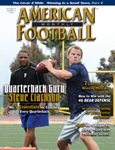Article CategoriesAFM Magazine
|
A Conditioning Program for Skill Positions Using Lunge Variations© More from this issueBy Kim E. Fischer, Ph.D., CSCS • Teri Walter, Ph.D. • Joseph Matovich, CSCS Department of Health and Sport Sciences, Otterbein University Position requirements for skill position players like running backs, defensive backs, wide receivers, and quarterbacks differ from the offensive and defensive line positions in that quickness, agility, change of direction, balance, body control, and reaction time are even more critical characteristics for player success. Skill position players are coming to the ball or to a player in a full sprint. They are playing more pass coverage that requires alternating between forward and backpedaling movements. A defensive back, for instance, might be sprinting, a horizontal movement, and have to jump in the air to deflect a pass or contest a reception, thus moving into a vertical plane. A....The full article can only be seen by subscribers.
|
|
|||||||
| HOME |
MAGAZINE |
SUBSCRIBE | ONLINE COLUMNISTS | COACHING VIDEOS |
Copyright 2025, AmericanFootballMonthly.com
All Rights Reserved





